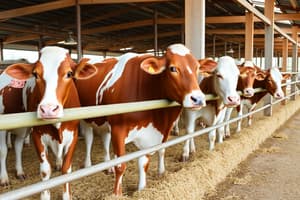Podcast
Questions and Answers
What is one benefit of improving the genetics of dairy herds?
What is one benefit of improving the genetics of dairy herds?
- Reduced overall efficiency
- Decreased milk production
- Higher reproduction costs
- Increased milk per cow (correct)
What environmental practice can help reduce greenhouse gas emissions on dairy farms?
What environmental practice can help reduce greenhouse gas emissions on dairy farms?
- Manure management (correct)
- Avoiding cover crops
- Overlooking nutrient runoff
- Increased tillage
Which technology has become common in modern dairy farming for milking cows?
Which technology has become common in modern dairy farming for milking cows?
- Computerized milking systems (correct)
- Robotic cleaning systems
- Hand-milking stations
- Manual calf feeding
What is the primary goal of implementing sustainability practices in dairy farming?
What is the primary goal of implementing sustainability practices in dairy farming?
How do advances in technology benefit dairy farming?
How do advances in technology benefit dairy farming?
Why do farmers continuously adapt and innovate in dairy farming practices?
Why do farmers continuously adapt and innovate in dairy farming practices?
What is the primary focus of dairy farming?
What is the primary focus of dairy farming?
Which of the following management practices is not mentioned in the text?
Which of the following management practices is not mentioned in the text?
Why is regular veterinary care important in dairy farming?
Why is regular veterinary care important in dairy farming?
What is the primary reason for implementing milk quality control measures?
What is the primary reason for implementing milk quality control measures?
What is the goal of selective breeding programs in dairy farming?
What is the goal of selective breeding programs in dairy farming?
Which trait is not mentioned as a focus of selective breeding programs?
Which trait is not mentioned as a focus of selective breeding programs?
Flashcards are hidden until you start studying
Study Notes
Dairy farming is a significant aspect of agriculture, providing essential products like milk, cheese, butter, and yogurt for consumers worldwide. This section discusses various dairy farming practices used by farmers to ensure efficient production while maintaining animal health and environmental sustainability.
Management Practices
Dairy farms follow specific management practices to optimize productivity, such as breeding cows with high milk yields, monitoring cow nutrition, and investing in advanced technology for milking and disease prevention. Regular veterinary care, including vaccinations and parasite control, also plays a crucial role in maintaining herd health. Economically viable farming operations rely on these practices to maximize profits while reducing risk.
Milk Quality Control
Maintaining high milk quality standards is essential for both farmer profitability and consumer safety. Farmers implement measures such as regular testing for pathogens and antibiotics, strict sanitation protocols, and regulating feeding practices to minimize contamination risks. By ensuring milk quality, farmers can command higher prices and meet demand for premium products.
Genetic Selection
Selective breeding programs aim to improve dairy cattle genetics through genetic selection. These programs focus on traits like milk yield, fertility, and resistance to diseases. By improving the genetics of their herds, farmers can produce more milk per cow, reduce costs associated with reproduction and health issues, and increase overall efficiency.
Environmental Sustainability
Environmental concerns have become increasingly important in modern dairy farming practices. Farmers are encouraged to implement systems that reduce greenhouse gas emissions, manage nutrient runoff effectively, and preserve natural resources. This may include practices like manure management, reduced tillage, cover crops, and crop rotation. By prioritizing sustainability, farmers can mitigate potential negative impacts on the environment while maintaining economic viability.
Robotics and Automation
Advances in technology have led to increased automation in many aspects of dairy farming. Computerized milking systems, automated calf feeding, and robotic cleaning and maintenance tasks have become commonplace on modern farms. These innovations can lead to increased productivity, improved working conditions for farmers, and more consistent milk quality.
In conclusion, dairy farming practices encompass a wide range of management strategies aimed at improving efficiency, maintaining animal health, and reducing environmental impact. From genetic selection to automation, farmers continuously adapt and innovate to meet the demands of modern agriculture while ensuring a sustainable future for dairy production.
Studying That Suits You
Use AI to generate personalized quizzes and flashcards to suit your learning preferences.




